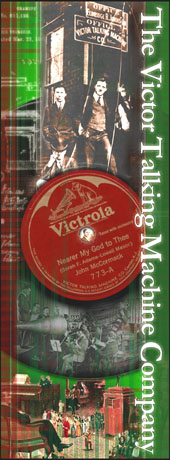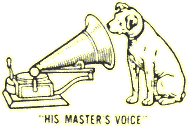 |

|
 |
|
 |
 |
[Online
Texts]
The Victor Talking Machine Company
by B. L. Aldridge
edited by Frederic Bayh
Editorial
Notes
These
pages outline the major developments of a company which led an industry
for almost three decades. To a great extent, they also reflect one
man's loyalty and dedication to that company. Through this manuscript,
Ben Aldridge has made a significant contribution to posterity. It is
impossible to read this material without being awed by the distance
this industry has travelled since its beginnings. Our understanding and
appreciation of what RCA Victor is today is immeasurably enhanced. The
author's deep sense of responsibility and perseverance has more than
earned our gratitude and respect.
RCA
SALES CORPORATION
June 1, 1964
CONTENTS
|
|
Preface
|
|
Introduction
|
|
Chapter 1
|
Page
1
|
| Scott and Edison |
-Sound
is Reproduced
-The Edison Phonograph Company
-The Search for a Formula
|
| Chapter 2 |
Page
5
|
| Bell and Tainter |
-The
New Process
-The American Graphophone Company
-Columbia
|
| Chapter 3 |
Page
9
|
| Emile Berliner |
-The
Berliner Process
-The Berliner Gramophone Company of Philadelphia
-The Berliner Patent
|
| Chapter 4 |
Page
17
|
| Eldridge R. Johnson |
-The
Development of a Motor
-The Johnson Recording Process
-The Patent Situation
-The Troubles Which Led to Victor
-The Victor Trade Mark
-The Company Name
|
| Chapter 5 |
Page
41
|
| 1901-1905 |
-Organization
-London
-Domestic Distribution
-Columbia Competition
-Policy
-Red Seal Records
-Record Development
-Instrument Line
-Advertising
-License to Sell
-The Burt Company
-The Zonophone
-The Fire
|
| Chapter 6 |
Page
61
|
| 1906-1911
|
-The
First "Victrola" Talking Machine
-Auxetophone
-Columbia's Graphonola
-License Plan
-Double-Faced Records
-Canada
-Sales Pressure
-Educational Activities
-Copyright Laws
-Recapitalization
-Trustee Stock
-Other Activities
|
| Chapter 7 |
Page
71
|
| 1912-1920
|
-Victor's
Welfare Activities
-License Royalty Plan
-The Flow of Production
-Steel Needles
-Printing Department
-Victor Traveling Staff
-Orders, Shipments, Allocations
-Camden Plant Expansion
-Feature Records and Record Specialties
-"Free Course in Practical Salesmanship"
-World War I
-Conventions
-Distributor Association
-Custom Department
-Columbia Financing
-Distributor Contacts
-Equalized Freight
-Lunch Club
-Cabinet Finishes
|
| Chapter 8 |
Page
85
|
| 1921-1930 |
-Wood
Carving
-Double-Faced Red Seal Records
-Advances Against Record Royalties
-The Debacle of 1924
-The Orthophonic Victrola
-The Electrola
-The Panatrope
-The New Instrument Line
-The First Automatic Record Changer
-Exports
-Display Rooms
-McCormack-Bori Radio Broadcast
-Johnson Sells Control
-Victor Acquired by RCA
-Summary
|
|
|
Appendices:
|
|
I Chronological Outline of
Important Developments
|
Page
103
|
II Historical Background of
Important Antique Models
|
Page
106
|
III Victor's Distributors
|
Page
107
|
IV Sales by Class of
Product-October 1, 1901 to April, 1930
|
Page
109
|
V Corporate Structure
|
Page
109
|
VI Dividends on Victor's Common
Stock
|
Page
110
|
VII Investments in Other Companies
|
Page
110
|
VIII Canada
|
Page
111
|
IX London
|
Page
112
|
X License Royalty
|
Page
113
|
XI Record Sales
|
Page
114
|
XII Key Personnel
|
Page
115
|
XIII Victor's Directors and
Officers
|
Page
116
|
XIV Eldridge Reeves Johnson - An
Autobiography
|
Page
117
|
|
|
Figures:
|
|
Figure 1 - Edison and his improved
tinfoil phonograph: Washington, D.C., April 18, 1878.
|
Page
3
|
Figure 2 - The original Bell
Graphophone (1881), now in the Smithsonian Institute.
|
Page
6
|
Figure 3 - First Talking Machine
(Gramophone) Exhibited in 1888.
|
Page
10
|
Figure 4 - The Instrument pictured
above is very similar to the model which Mr. Whitaker brought to Mr.
Johnson in February of 1896.
|
Page
12
|
Figure 5 - The birthplace of Victor.
|
Page
19
|
Figure 6 - The first talking
machine patent granted to Mr. Johnson on March 22, 1898.
|
Page
21
|
Figure 7 - The Collins Carriage
Shop-birthplace of the Johnson Recording Process.
|
Page
23
|
Figure 8 - The Zonophone becomes
nationally advertised, 1898.
|
Page
27
|
Figure 9 - Eldridge R. Johnson as
a young man of 33.
|
Page
30
|
Figure 10 - Zonophone
advertisement in the November 1900 issue of McClure's Magazine.
|
Page
32
|
Figure 11 - Instrument line
introduced by Eldridge Johnson in the Fall of 1900.
|
Page
34
|
Figure 12 - "His Master's Voice"
painted by Francis Barraud in 1899.
|
Page
36
|
Figure 13 - Mr. and Mrs. Leon
Forrest Douglass.
|
Page
38
|
Figure 14 - Early records and
brand names.
|
Page
40
|
Figure 15 - The original
instrument line offered by the Victor Talking Machine Company.
|
Page
42
|
Figure 16 - Victor's first factory
office located at 114 N. Front Street in Camden, New Jersey.
|
Page
44
|
Figure 17 - Advertisement in "The
Review of Reviews"-1904.
|
Page
48
|
Figure 18 - Advertisement in "The
Cosmopolitan"-1903.
|
Page
50
|
Figure 19 (p. 52)-Recording for
the Acoustic process.
|
Page
52
|
Figure 20 - Advertisement in the
"Literary Digest"-1915.
|
Page
54
|
Figure 21 - On April 24, 1904, a
large fire destroyed the first factory building used by Victor.
|
Page
60
|
Figure 22 - Evolution of Model
VV-XVI, the first Talking Machine with an enclosed horn.
|
Page
62
|
Figure 23 - Semi-monthly
suspension report issued by the Victor Talking Machine Company-1907.
|
Page
64
|
Figure 24 - Advertisement
featuring Victor's custom models-1924.
|
Page
82
|
Figure 25 - Model 8-30. The public
invested approximately $20,000,000 on this one model in slightly less
than a year.
|
Page
90
|
Figure 26 - The above is a good
example of the Company's use of curiosity and suspense in announcing
the Orthophonic Victrola.
|
Page
94
|
|

|


